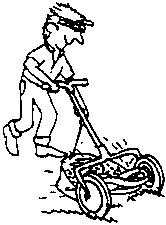






Green Up Your Earth toDay
Take these 10 steps to make your life more environmentally friendly
by Mark Harris, reprinted from Vegetarian Times, April 96, with permission
 hile packing for our move east last year, I came across
one of those "save the Earth" checklists that were circulating
the planet during the 1990 Earth Day extravaganza. This one had been posted
on our refrigerator for a couple of years, and as I read it I was struck
by how many of the suggestions actually had become part of our domestic
routine: the canvas shopping bags that we tote to and from the grocery store,
the ceramic coffee mugs we stow in our book bag and briefcase, the low-voltage
compact fluorescent lamps that still burn strong after five years of heavy
use, the low-flow shower head in the bathroom, the cloth napkins at the
dinner table.
hile packing for our move east last year, I came across
one of those "save the Earth" checklists that were circulating
the planet during the 1990 Earth Day extravaganza. This one had been posted
on our refrigerator for a couple of years, and as I read it I was struck
by how many of the suggestions actually had become part of our domestic
routine: the canvas shopping bags that we tote to and from the grocery store,
the ceramic coffee mugs we stow in our book bag and briefcase, the low-voltage
compact fluorescent lamps that still burn strong after five years of heavy
use, the low-flow shower head in the bathroom, the cloth napkins at the
dinner table.
 Some of the checklists from that period even went as
far as to suggest eating less meat (though few were bold enough to advocate
a vegetarian diet). Going vegetarian certainly "outgreens" many
other actions because of the dramatic environmental cost of the meat and
poultry industries. A diet centered around grains and vegetables requires
one-sixth the amount of cropland, a fraction of the amount of chemical fertilizers
and pesticides, and one-thirteenth the amount of water needed to support
a meat-based diet. Every 16 pounds of grain or soybeans fed to cattle yields
only one pound of meat, and one-third of our gas, oil and coal is used by
the beef, poultry and dairy industries.
Some of the checklists from that period even went as
far as to suggest eating less meat (though few were bold enough to advocate
a vegetarian diet). Going vegetarian certainly "outgreens" many
other actions because of the dramatic environmental cost of the meat and
poultry industries. A diet centered around grains and vegetables requires
one-sixth the amount of cropland, a fraction of the amount of chemical fertilizers
and pesticides, and one-thirteenth the amount of water needed to support
a meat-based diet. Every 16 pounds of grain or soybeans fed to cattle yields
only one pound of meat, and one-third of our gas, oil and coal is used by
the beef, poultry and dairy industries.
 But as I perused that list, it occurred to me that I
was probably in good company in asking "what next?" What we're
already doing is beneficial, but after half a decade, we're ready to do
more.
But as I perused that list, it occurred to me that I
was probably in good company in asking "what next?" What we're
already doing is beneficial, but after half a decade, we're ready to do
more.
 The 10 steps that follow will challenge you. Some will
require a bit of effort; some will be possible only if you make some big
changes in your life. And some you will choose not to do. Few people will
be able to adopt all of these Earth-friendly strategies, and certainly not
all at once. So pick and choose among those that resonate for you. Adopt
them partially, or in the whole. But follow even one or two and you'll tread
that much more lightly on the small corner of the planet you call home.
The 10 steps that follow will challenge you. Some will
require a bit of effort; some will be possible only if you make some big
changes in your life. And some you will choose not to do. Few people will
be able to adopt all of these Earth-friendly strategies, and certainly not
all at once. So pick and choose among those that resonate for you. Adopt
them partially, or in the whole. But follow even one or two and you'll tread
that much more lightly on the small corner of the planet you call home.
1 Compost
Compost


Composting has a reputation as a labor-intensive, grimy art, the kind of
Herculean endeavor one might expect only from rural homesteaders, longtime
subscribers to Organic Gardening or the phylum of horticultural environmentalists
who own a shed of precision English gardening tools and grow vegetables
in glass hot-boxes during the winter months. But composting can be a surprisingly
painless operation, thanks to a natural law that says kitchen scraps and
yard waste - which account for three-fourths of our household garbage -
will decompose of their own accord. During a busy part of my life, I relied
heavily on that law, simply tossing my compostables onto a more or less
open pile in the backyard. For my minimal effort I was rewarded with crumbly
compost that nourished our spring vegetable plot.
 Of course, better compost - the loamy stuff chock full
of the nutrients that boost a garden's harvest - comes from a more scientific
approach: mixing a good 20-to-1 ratio of carbon (brown leaves) to nitrogen
(green grass and kitchen scraps). Allow air to circulate through the pile,
keep it moist, protect the mix from the elements, and give the pile an occasional
turn with a pitchfork or shovel. The quality of my compost improved dramatically
when I began dumping my organic waste into a wooden box I fashioned from
four discarded shipping pallets lashed together at the comers. The eco-catalogs
have prefabricated models, some of which practically eliminate effort altogether.
One is a compost-containing ball that spins in place to aerate the contents;
another is a compact plastic bin filled with scrap-eating worms. Toss kitchen
trimmings into the bin and these wiggly composters will break it down into
supercharged potting soil. The bin fits under the sink, perfect for apartment
dwellers.
Of course, better compost - the loamy stuff chock full
of the nutrients that boost a garden's harvest - comes from a more scientific
approach: mixing a good 20-to-1 ratio of carbon (brown leaves) to nitrogen
(green grass and kitchen scraps). Allow air to circulate through the pile,
keep it moist, protect the mix from the elements, and give the pile an occasional
turn with a pitchfork or shovel. The quality of my compost improved dramatically
when I began dumping my organic waste into a wooden box I fashioned from
four discarded shipping pallets lashed together at the comers. The eco-catalogs
have prefabricated models, some of which practically eliminate effort altogether.
One is a compost-containing ball that spins in place to aerate the contents;
another is a compact plastic bin filled with scrap-eating worms. Toss kitchen
trimmings into the bin and these wiggly composters will break it down into
supercharged potting soil. The bin fits under the sink, perfect for apartment
dwellers.
2 Keep your car parked
Keep your car parked



Thanks to some major downsizing and innovative tinkering, the automobile
has become a leaner and, consequently, greener machine in the last decade,
but it's still hardly a friend to the environment. The exhaust puffing from
the tailpipes of our nation's 190 million automobiles contributes to smog,
depletion of the ozone layer and the greenhouse effect, as well as their
accompanying health effects. The infrastructure that supports the automobile
isn't kind to the environment either: enough countryside has been paved
over for roads to cover the entire state of Georgia.
 Give your lungs a breather; keep your car parked as
often as you can. Hop a bus, bike or walk. Consolidate a list of errands
into a single outing or carpool to work.
Give your lungs a breather; keep your car parked as
often as you can. Hop a bus, bike or walk. Consolidate a list of errands
into a single outing or carpool to work.
3 Buy less stuff
Buy less stuff
Want to really help the environment? Stop buying unnecessary stuff. It's
our demand for more things that fuels destruction of the natural environment:
the trees that are felled for our Sunday morning newspapers and Adirondack
lawn chairs, the mountains stripped for coal to fire the factories churning
out everything from sauté pans to minivans.
 You'll be more green - and save more green - if you
can check the impulse to reach for your credit card when those catalogs
arrive in the mail, when the electronics outlet showcases an even bigger,
wider-screen television, or when you simply have an urge to buy something.
If the urge is overwhelming, enlist help to stay the consumer twitch. Require
a skeptical mate to clear all purchases over $15 dollars (tightwads are
best). We record every dime we spend on a sheet posted in the pantry closet
as an inspiration to keep purchases to a minimum and come in under a previous
month's outlay. Friends of ours designate two "poor months" each
year, during which they buy only the absolute basics. Then they bank the
savings.
You'll be more green - and save more green - if you
can check the impulse to reach for your credit card when those catalogs
arrive in the mail, when the electronics outlet showcases an even bigger,
wider-screen television, or when you simply have an urge to buy something.
If the urge is overwhelming, enlist help to stay the consumer twitch. Require
a skeptical mate to clear all purchases over $15 dollars (tightwads are
best). We record every dime we spend on a sheet posted in the pantry closet
as an inspiration to keep purchases to a minimum and come in under a previous
month's outlay. Friends of ours designate two "poor months" each
year, during which they buy only the absolute basics. Then they bank the
savings.
 Other tactics that work: don't seek entertainment in
places of commerce, such as the mall, where it's nearly impossible not to
buy something. Head to the store with a shopping list in hand and stick
to it. Think first to borrow, barter or rent, and then to buy used.
Other tactics that work: don't seek entertainment in
places of commerce, such as the mall, where it's nearly impossible not to
buy something. Head to the store with a shopping list in hand and stick
to it. Think first to borrow, barter or rent, and then to buy used.
4 Spend time in nature
Spend time in nature



Perhaps the reason we don't fight as passionately against the degradation
of our natural environment is because we spend so little of our time in
it. It's hard to get worked up about the felling of a forest you've never
camped in, the silting of a river you haven't rafted, the bulldozing of
the woods you never walked. Maybe that's why our greatest advocates of natural
spaces actually lived there: Thoreau on Walden Pond; John Muir in the Sierra
Mountains; Aldo Leopold on Sand Island; Edward Abbey in the canyon country
of southeast Utah.
 Go for a day hike in the mountains, spend a night in
a national park or simply walk into a wild spot off the beaten path. Don't
know where to go or don't want to venture out alone? Contact your local
Sierra Club, which sponsors regular group outings.
Go for a day hike in the mountains, spend a night in
a national park or simply walk into a wild spot off the beaten path. Don't
know where to go or don't want to venture out alone? Contact your local
Sierra Club, which sponsors regular group outings.
5 Reuse
Reuse




We seem to have forgotten about this high-green option that keeps otherwise
discarded materials in the loop. Recycling grabs our attention, but it typically
takes much less energy to keep goods in play by reusing them.
 Repairing makes reusing possible: well-worn shoes can
be resoled, dated suits can be salvaged by having their lapels tailored.
One saint of a mechanic re-welded a cracked clutch in our Honda, saving
the material required for a new replacement (and a fair amount of money).
There are a host of companies that refurbish old computer discs, video tapes,
computer ribbons and toner cartridges.
Repairing makes reusing possible: well-worn shoes can
be resoled, dated suits can be salvaged by having their lapels tailored.
One saint of a mechanic re-welded a cracked clutch in our Honda, saving
the material required for a new replacement (and a fair amount of money).
There are a host of companies that refurbish old computer discs, video tapes,
computer ribbons and toner cartridges.
 We can also choose reusable alternatives for the things
we routinely need, such as cloth handkerchiefs over paper tissues, cloth
or metal coffee filters instead of the paper ones. Feeling adventurous?
Start shaving with a straight razor and keep a small fraction of the 2 billion
disposable blades discarded every year out of the trash.
We can also choose reusable alternatives for the things
we routinely need, such as cloth handkerchiefs over paper tissues, cloth
or metal coffee filters instead of the paper ones. Feeling adventurous?
Start shaving with a straight razor and keep a small fraction of the 2 billion
disposable blades discarded every year out of the trash.
6 Landscape for fuel efficiency
Landscape for fuel efficiency
You can cut home energy needs by 30 percent by arranging plants and landforms
so that they shade a home in the summer and buffer it from icy winds in
the winter.
 Generally, you want to plant broadleaf, deciduous trees
along the south front of your home, where the summer sun strikes at its
fullest. A Norway maple, for example, can block up to 75 percent of the
sun's energy and 95 percent of its light during the hot summer months, and
since it's sparsely foliated at ground level, it allows low-lying cooling
breezes to reach the house. The maple sheds its cover in winter, allowing
the sun's warming beams to reach the house unhindered. Shorter, lower-density
trees planted along the eastern and western side of a home can block the
summer's bright early morning and late afternoon sun; a row of thick evergreens
on the north and northwest perimeter can blunt frigid Arctic winds.
Generally, you want to plant broadleaf, deciduous trees
along the south front of your home, where the summer sun strikes at its
fullest. A Norway maple, for example, can block up to 75 percent of the
sun's energy and 95 percent of its light during the hot summer months, and
since it's sparsely foliated at ground level, it allows low-lying cooling
breezes to reach the house. The maple sheds its cover in winter, allowing
the sun's warming beams to reach the house unhindered. Shorter, lower-density
trees planted along the eastern and western side of a home can block the
summer's bright early morning and late afternoon sun; a row of thick evergreens
on the north and northwest perimeter can blunt frigid Arctic winds.
7 Invest in your community
Invest in your community
Decisions are being made every day that have some bearing on the quality
of the environment around you. Approval of a zoning variance allows a developer
to build a strip mall next to a neighborhood; a local cement kiln is given
the right to increase the amount of toxic refuse it burns in a year; the
city council agrees to sell a park to a company that would blacktop it into
a parking lot. These are just a few of the issues that have been raised
in my area.
 Decisions of potentially huge consequence are made at
public meetings that go largely unattended by the people most affected by
them. Attend your city council meetings and community boards, run for a
spot on the planning commission, speak up at the open mike, circulate petitions
around your block or write editorials for your local newspaper. Want to
improve the quality of your community but not sure where to start? Meet
with your neighbors, walk around and survey your neighborhood, and draft
a vision of the kind of place you want it to be. And then work together
for it.
Decisions of potentially huge consequence are made at
public meetings that go largely unattended by the people most affected by
them. Attend your city council meetings and community boards, run for a
spot on the planning commission, speak up at the open mike, circulate petitions
around your block or write editorials for your local newspaper. Want to
improve the quality of your community but not sure where to start? Meet
with your neighbors, walk around and survey your neighborhood, and draft
a vision of the kind of place you want it to be. And then work together
for it.
8 Plant a garden
Plant a garden





Dig out a plot that gets the bulk of the day's sun and plant the vegetables
you eat most often. The fare you pull from the ground will be healthier
and tastier than store-bought, and you'll bypass all the environmental costs
that are racked up in the production and transport of commercial produce.
Don't forget to mix in the compost from step one.
 Cook your meals from scratch, making as much use as
possible of your home-grown produce. Every time you eat a garden-fresh tomato
or cucumber, you've saved the environmental toll of harvesting and transporting
supermarket produce. If you grow enough food so you shop less often, you
eliminate some of the costs associated with driving to and from the store.
Cook your meals from scratch, making as much use as
possible of your home-grown produce. Every time you eat a garden-fresh tomato
or cucumber, you've saved the environmental toll of harvesting and transporting
supermarket produce. If you grow enough food so you shop less often, you
eliminate some of the costs associated with driving to and from the store.
9 Eliminate your lawn service
Eliminate your lawn service
The plush, uniform carpet of green grass we ardently strive for is anything
but natural. Every year, American homeowners shell out $6 billion in lawn-care
aids, arming ourselves with an average of five to 10 pounds of chemical
pesticides per acre of yard in order to keep real nature at bay. Most of
these pesticides are suspected of causing long-term health problems; a report
in the American Journal of Public Health (February 1995) found that children
whose yards had been treated with chemical weed and insect killers were
four times as likely to develop cancer than other kids.
 A "greener" lawn is the casual one favored
by our early American ancestors - a mixture of wildflowers, colorful weeds
and odd plantings that sprang from the ground of their own accord. It was
low on maintenance, high on aesthetic appeal. If such a lawn is too great
a departure for your neighborhood, at least plant grasses that more naturally
fit their sites; your local agricultural extension agent can tell you what
varieties to look for.
A "greener" lawn is the casual one favored
by our early American ancestors - a mixture of wildflowers, colorful weeds
and odd plantings that sprang from the ground of their own accord. It was
low on maintenance, high on aesthetic appeal. If such a lawn is too great
a departure for your neighborhood, at least plant grasses that more naturally
fit their sites; your local agricultural extension agent can tell you what
varieties to look for.
 Once you've got the right variety planted, consider
using a human-powered reel or push mower. A power mower running one hour
spews the same amount of smog-causing volatile organic compounds as a car
travelling 50 miles. In fact, the total toxic emissions of the 18 million
gas-fed mowers out there is significant enough that the U.S. Environmental
Protection Agency has set emission standards for new models of gas mowers.
Once you've got the right variety planted, consider
using a human-powered reel or push mower. A power mower running one hour
spews the same amount of smog-causing volatile organic compounds as a car
travelling 50 miles. In fact, the total toxic emissions of the 18 million
gas-fed mowers out there is significant enough that the U.S. Environmental
Protection Agency has set emission standards for new models of gas mowers.
 The human-powered mower eliminates air pollution altogether
- and it's better for your lawn and for you! The push mower snips grass
as neatly as scissors, producing a clean, even cut and sealing in fluids
that are vital to the health of the plant. The blades on a power mower dull
easily, and with their slashing motion don't cut grass as cleanly, leaving
it vulnerable to disease and drought. Need more incentive? Pushing a reel
mower burns up to 350 calories an hour - a workout equivalent to singles
tennis, downhill skiing and aerobic dance.
The human-powered mower eliminates air pollution altogether
- and it's better for your lawn and for you! The push mower snips grass
as neatly as scissors, producing a clean, even cut and sealing in fluids
that are vital to the health of the plant. The blades on a power mower dull
easily, and with their slashing motion don't cut grass as cleanly, leaving
it vulnerable to disease and drought. Need more incentive? Pushing a reel
mower burns up to 350 calories an hour - a workout equivalent to singles
tennis, downhill skiing and aerobic dance.
 Mowing less frequently, and during times of the season
appropriate for the strain of grass you've planted, will also help you maintain
a healthy lawn naturally. If fertilizer is a must, go for natural mixes,
such as manure compounds or all-in-one fertilizers made from dried sewage
sludge. Still too much effort? Then contact NaturaLawn, a national lawn-care
company that employs organic fertilizers and more natural approaches to
weed and pest prevention.
Mowing less frequently, and during times of the season
appropriate for the strain of grass you've planted, will also help you maintain
a healthy lawn naturally. If fertilizer is a must, go for natural mixes,
such as manure compounds or all-in-one fertilizers made from dried sewage
sludge. Still too much effort? Then contact NaturaLawn, a national lawn-care
company that employs organic fertilizers and more natural approaches to
weed and pest prevention.
10 Teach your children well
Teach your children well
You can cap your shower head, caulk your windows and slice up your credit
cards, but your efforts won't cause the kind of long-term environmental
gain you're seeking unless your kids - the next generation - follow suit.
Environmental awareness, I'm convinced, begins at an early age, learned
by 2-year-olds who carry their finished apples out to the compost pile and
see that over time they rot. In the spring, our own little girl will help
dig the compost she helped create into our vegetable garden and know her
apple is in there somewhere, bringing us fresh tomatoes.

 Mark Harris writes a weekly column on environmental
issues for The Los Angeles Times Syndicate.
Mark Harris writes a weekly column on environmental
issues for The Los Angeles Times Syndicate.
The Vegetarian Times is published monthly by Vegetarian Times, Inc., 4 High
Ridge Park, Stamford, CT 06905.


Green Up Resources
Diet for a New America by John Robbins (Stillpoint Publishing,
1987), $10.95. The goods on the health and ecological benefits of a vegetarian
diet.
Let It Rot!: The Gardener's Guide to Composting by Stu Campbell
(Storey communications, 1990). $8.95. Composting demystified and made easy.
Seventh Generation, 49 Hercules Drive, Colchester, VT 05446-1672;
(800) 456-1177. Catalog of environmentally friendly clothing, and house
and garden products.
Choose to Reuse by Nikki and David Goldbeck (Ceres Press,
1995), $15.95. Practical tips for keeping goods in circulation, from air
filters to zippers.
Planning to Stay by William Morrish and Catherine Brown (Milkweed
Editions, 1994), $16.95. How-to on learning to see your neighborhood afresh
and improve it.
Energy-Efficient and Environmental Landscaping by Anne Simon
Moffat and Marc Schiler (Appropriate Solutions Press: Dover Road, Box 39,
South Newfane, VT 05351), $19.95. Detailed instruction on how to weatherize
a home by modifying the landscape surrounding it.
The Chemical-Free Lawn by Warren Schultz (Rodale Press, 1989),
$14.95. The bible of a natural, holistic approach to yard care, calling
for increased vigilance, careful watering and mowing, and natural bug deterrent.
NaturaLawn Inc., 141 W. Patrick St., Frederick, MD 21701: (301) 694-5440.
National organic-based lawn-care company. - M. H.













Mark Harris writes a weekly column on environmental
issues for The Los Angeles Times Syndicate.